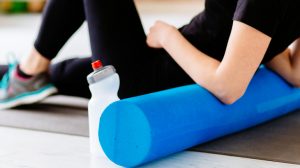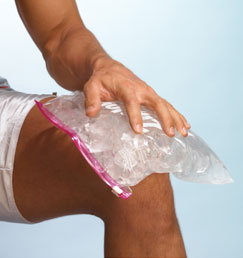Achilles Tendon Disorder
Achilles Tendon Disorder
Massage therapists see many clients with active lifestyles. Running, jumping, dancing, climbing, or any number of other activities can put serious stress on the Achilles tendon (AT). AT disorders also can contribute to biomechanical disorders in the foot and lower extremity.
That is why it is important for the massage practitioner to understand more about the structure, function and pathology of this very important tendon.
The AT is the strongest tendon in the body and needs this strength because of the high force loads required during motions such as walking, running or landing from a jump. AT disorders can occur at any age, but there is an increased frequency in older populations. The increased age of the active baby boomer generation in this country suggests we likely are to see more of this condition in years to come. The tendon is susceptible to a variety of pathologies, such as paratendinitis (also spelled paratendonitis), tendinosis and tendinitis. Some of these different terms can be confusing, so I'll distinguish them below.
Structure, Function and Pathology
The AT connects the gastrocnemius and soleus muscles to the calcaneus. The tendon is surrounded by a thin membrane called the paratenon, which helps facilitate blood supply throughout the tendon. There is a region of the AT near the distal insertion, called the avascular zone that has a very poor blood supply (Figure 1). This region frequently is the site of inflammation and degenerative changes within the tendon.
The term tendinitis is used for overuse tendon pathologies throughout the body. Yet, most of these conditions do not involve inflammation so they truly aren't tendinitis (the suffix -itis indicates inflammation). Yet the AT is one tendon that commonly does have inflammatory activity in the tendon and the paratenon. Consequently, the terms tendinitis and paratendinitis usually are accurate when referring to the AT.
Achilles tendinitis is classified as insertional or non-insertional. Insertional tendinitis involves pathology at the insertion of the AT into the calcaneus. It is prevalent in older individuals and those who engage in activities without proper conditioning. Poor healing of minor tendon damage occurs at the calcaneal tendon insertion due to the lack of blood supply in the avascular region.1
The second category of overuse AT disorders is non-insertional tendonitis - those that don't affect the insertion of the tendon into the calcaneus, but cause problems in other areas of the tendon. Non-insertional tendinitis typically affects athletes and those engaged in vigorous physical activity. The pathologies under the umbrella of non-insertional tendinitis include paratendonitis (inflammation of the paratenon), tendinosis (collagen degeneration within the tendon) and tendinitis (inflammation of the tendon).
Tendinosis is degeneration of the collagen matrix within the tendon, which leads to pain and loss of function. It commonly is categorized as non-insertional tendinitis, even though it is not an inflammatory disorder. The degenerative changes of tendinosis are caused by age, repetitive microtrauma or other factors that lead to collagen breakdown. The collagen degeneration frequently precedes inflammatory conditions such as tendinitis.
Non-insertional tendinitis can be acute or chronic and primarily affects the avascular zone near the base of the tendon. There is tenderness throughout the tendon and fibrous thickening near the distal end, which is apparent when the tendon is compared to the unaffected side (assuming the other side is not affected). In many cases, tendinitis and paratendinitis occur together and both the tendon and paratenon are inflamed. If not treated properly, tendinitis can lead to either partial or complete tendon ruptures.2
Recent studies show a link between certain medications and the onset of AT degeneration and ruptures. Especially implicated are medications in the fluoroquinolone family of antibiotics, such as ciprofloxacin (brand named Cipro).3-5 These medications cause tendon pathology in large tendons of the body, even in the absence of vigorous repeated activity. In addition, systemic disorders such as hyperthyroidism, renal insufficiency, gout or rheumatoid arthritis also can contribute to tendinitis in the AT.6,7
Treatment Considerations
AT disorders are best controlled through rest and activity modification. Rest means stopping offending activities, not immobilization. Lack of movement might lead to the development of fibrous adhesions. Cold applications and anti-inflammatory medication may be used to address inflammatory activity if present. As soon as stretching is tolerable, it is helpful to stretch the AT several times per day.
Massage applications to the calf muscles reduce tension and decrease tensile forces on the tendon. Deep friction, as tolerated in the problem area, is beneficial in stimulating fibroblast proliferation in the tendon to repair the damaged collagen matrix. Cold applications prior to the deep friction reduce the intensity of the discomfort, and reapplying cold after treatment reduces the accelerated metabolic response to the friction. Heel lifts inside the shoe may be recommended to help reduce tension on the tendon. Corticosteroid injections formerly were used with greater frequency and are not recommended now because of long-term detrimental effects on the tendon, such as tendon rupture.8 Massage therapists applying these concepts of evaluation and treatment will be much more effective in helping their clients address this frequent cause of foot and lower leg pain.
References
- Carr AJ, Norris SH. The blood supply of the calcaneal tendon. J Bone Joint Surg Br, Jan 1989;71(1):100-1.
- Corrigan B, Maitland GD. Musculoskeletal and Sports Injuries. Oxford: Butterworth Heinemann, 1994.
- Huston KA. Achilles tendinitis and tendon rupture due to fluoroquinolone antibiotics. N Engl J Med, 1994;331(11):748.
- Harrell RM. Fluoroquinolone-induced tendinopathy: what do we know? South Med J, 1999;92(6):622-5.
- Williams RJ, Attia E, Wickiewicz TL, Hannafin JA. The effect of ciprofloxacin on tendon, paratenon, and capsular fibroblast metabolism. Am J Sports Med, May-Jun 2000;28(3):364-9.
- Matsumoto K, Hukuda S, Nishioka J, Asajima S. Rupture of the Achilles tendon in rheumatoid arthritis with histologic evidence of enthesitis. A case report. Clin Orthop Relat Res, Jul 1992(280):235-40.
- Lesic A, Bumbasirevic M. Disorders of the Achilles tendon. Current Orthopedics, 2004;18:63-75.
- Shrier I, Matheson GO, Kohl HW III. Achilles tendonitis: are corticosteroid injections useful or harmful? Clin J Sport Med, 1996;6(4):245-50.
Ready to #feelbetter?
You're just a click away from a wicked good massage!
-

60 Minute Massage Gift Card
$170.00 Add to cart -

90 Minute Massage Gift Card
$255.00 Add to cart -

Mini Aer Small Room Air Purifier
$149.00 Add to cart -
Sale!

Thera-Pearl Sports Pack/Hot Cold
Original price was: $14.99.$12.99Current price is: $12.99. Add to cart -

3 Somadome Sessions Gift Card
$135.00 Add to cart -
Sale!

TheraBand® Stretch Strap
Original price was: $19.99.$14.99Current price is: $14.99. Add to cart -

20 Minute Somadome Gift Card
$45.00 Add to cart -

TheraBand CLX Connective Loop
$14.99 Select options
May Flowers-Life Hack
April Showers Bring 5 Flower Hacks What do you get when you combine soda, vodka, apple cider vinegar, hair spray & bleach? Some incredible ways to preserve your flowers this season. Sure, April showers bring May flowers, but mother nature went a tad over board with it this April. So how well are you prepared…
Read More#FeelBetterBoston Recap
#FeelBetterBoston Recap The inaugural #FeelBetterBoston Massage & Community Wellness event over Marathon weekend left people with a smile on their face and genuine appreciation for all that was provided. We knew this being the first time we held such an event that we would be competing with the likes of the infamous BAA Expo and other…
Read MoreHow Do You Roll??
How Do You Roll?? Are Foam Rolling Advocates Stretching the Truth? Foam rolling is one of the most common means of self-care for so many people. It has been thought to provide many benefits such as enhanced performance, improved flexibility and speed, pain reduction and muscle recovery. Often it is referred to as a self-massage technique,…
Read MoreOn the Mend
On the Mend As we quickly approach the holy grail of running events, the Boston Marathon, we start to see a rise in our battered and beaten road warriors. Overuse conditions from months of increased training, acute injuries from falls on slippery roads and chronic aches and pains, all result in the patient surrendering to…
Read MoreLife Hack: Watch the SB LIII on TV, but LISTEN on the Radio
Life Hack: Watch the SB LIII on TV, but LISTEN on the Radio So, our beloved Pats are back in the big game again. I’m not going to relay stats and numbers that drive home the dynasty known as the New England Patriots. We are all aware of them. However, if you want to enjoy…
Read MoreCortisone Injections: Yay or Ney?
Cortisone Injections: Yay or Ney? As massage therapists, we often see patients who have been struggling to find an answer for a particular pain problem. Some of these cases are acute (sudden onset) where others may be chronic (reoccurring over a long period of time). It is not uncommon to have a patient ask us…
Read MoreChiropractic Care at The Boston Bodyworker
Chiropractic Care at The Boston Bodyworker We are excited to announce the arrival of Dr. Jean Kelly of Momentum Healthcare to our office. Dr. Kelly has been practicing in our building for the past 10 years and has been a friend to The Boston Bodyworker for almost 20 years. We are honored to have her…
Read MoreSpine Health: Don’t Ignore It!
Spine Health: Don’t Ignore It! The new year always provides us with the feeling of having a clean slate. Let’s face it, most of us don’t take very good care of our spines. 2019 can be the year that your resolutions come true. This lack of care can lead to physical discomfort and make us…
Read MoreLife Hack: Drink Tea
Life Hack: Drink Tea With the rainiest and most dreary Fall in recent time behind us and winter now in full swing, the need for us to provide optimal care for ourselves is high. Despite American’s love affair with coffee, tea is really the more versatile of the beverages. Most of us reach for a…
Read MoreLife Hack: Forward Head Posture
Life Hack: Forward Head Posture How many times in the course of a day do you roll your shoulders and neck around to alleviate “the spot” in between your shoulder blades. There are several reasons for the discomfort you are experiencing, but one way to resolve this is to do what is known as a…
Read More



